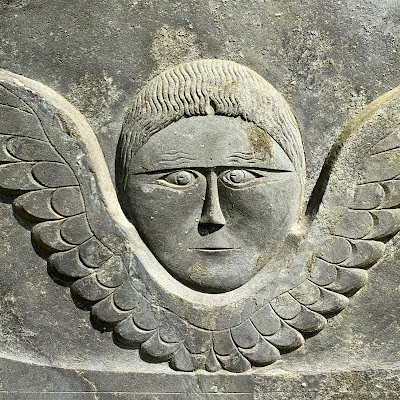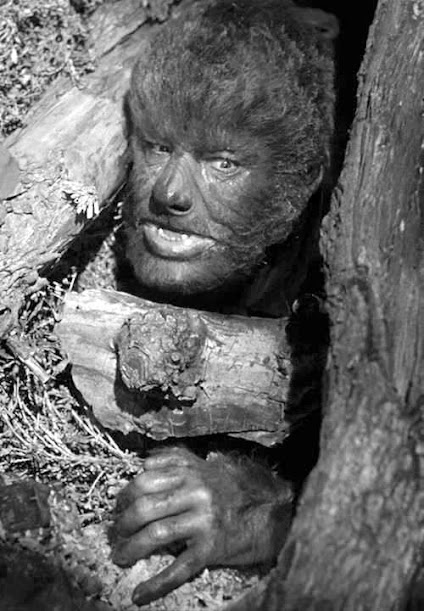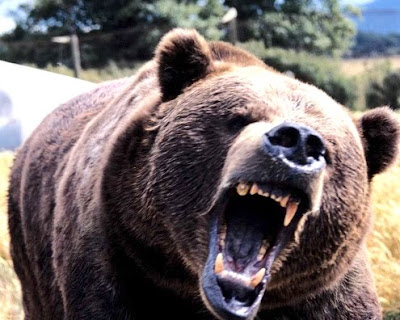Tony and I recently took a weekend trip up to Vermont. Our final destination was Montpelier to see an old friend, but we made a few stops along the way. Some people visit Vermont to see fall foliage and quaint towns. We wanted to see the Pigman!
The Pigman is the resident monster of Northfield, Vermont, a cute little town best known as the home of Norwich University, the oldest private military college in the United States. But if you journey outside the charming downtown and into the dense woods, according to legend you might encounter the half-human, half-porcine horror known as the Pigman. He's said to lurk most frequently in an area known as the Devil's Washbowl, a densely wooded, rocky, and remote area.
Way back in 1971, a Northfield farmer's twenty-year old son disappeared from home. Perhaps he had run away to the big city, the police suggested. He was never found, but shortly after his disappearance various animals went missing around town as well: mostly dogs and cats. Were these things connected?
One night a farmer heard something rummaging through his garbage cans. Thinking it was a raccoon, the farmer flicked on his outside light. It wasn't a raccoon. It was a naked man. His body was covered in short white hair, and he had the face of a pig. The man - creature? - ran off into the darkness.
A few weeks later, during a high-school dance, four students were smoking and drinking in a sand pit behind the school. As they talked, they saw something move towards them in the night. It was a naked man with the hideous face of a pig. Terrified, the four students ran into the school gymnasium and told their friends what they had seen. A group of students ran out to see the creature, but it had vanished, leaving behind only beaten-down undergrowth as proof it had been there.
Jeff Hatch was one of the students that rushed out to find the Pigman, and many years later he told Vermont author Joseph Citro about the creature. Citro included the legend in his book Green Mountains, Dark Tales, and in subsequent books, like Weird New England and The Vermont Monster Guide. According to Hatch, locals at first suspected the Pigman was living at a nearby pig farm (which makes sense), but many motorists that year reported seeing a strange white creature near the Devil's Washbowl, a stony hillside depression that a stream runs through. A young couple that had parked their car near the Devil's Washbowl for a romantic interlude also claimed the Pigman had attacked them, and the young man had the claw marks on his body to prove it.
Small piles of bones and piles of hay, which seemed to have been used as bedding, were found in caves near the Devil's Washbowl, further lending credence to the idea it was the Pigman's lair. Jeff Hatch claims the police went to investigate, but never found anything.
Some people want to see the Eiffel Tower or the Pyramids. Ever since reading this story, I've wanted to see the Devil's Washbowl, so we made it a stop on our Vermont trip. Devil's Washbowl Road is easy to find on Google maps, but when we visited it was not marked by any street signs. (It looked like they had been stolen by vandals.) It's a dirt road that wends its way along a steep, wooded hillside. There are a few houses and farms along the road, but mostly you're in the woods. Devil's Washbowl Road is pretty, but it also reminded me of the beginning of a horror movie, particularly as we were two city boys out of our element.
I had asked Joseph Citro how to find the Washbowl itself, and he told me I would see it when the road passed over a culvert. After mistakenly thinking a small stream was it, we came to the actual Devil's Washbowl. Many geologic features in New England bear the Devil's name, often because they are rough and vaguely inhospitable to humans. This is one of them. A stream runs down a rocky hillside, empties into a rocky basin, and then disappears into the woods. I haven't found a specific legend explaining the origin of the Washbowl's name, but it does look like someplace where the Devil would wash his hands after committing a nefarious deed.
 |
| Would you go down there? We did not... |
We pulled over and got out of the car to take some photos. Other than the sound of rushing water, it was very quiet. I debated climbing down into the Washbowl itself to find one of the caves, but I (wisely) decided not to. My main concerns: breaking a leg, getting Lyme disease, touching poison ivy, getting eaten by the Pigman. Four good reasons to stay near the car. And then Tony noticed a good reason to get back in the car: a big piece of animal scat, relatively fresh. Was it from a bear, or maybe a coyote? Or perhaps it was from a half-man, half-pig, humanoid monster? We didn't stick around to find out.
Jeff Hatch seemed to think the Pigman was actually the farmer's son who went missing in 1971, who somehow devolved after living in the woods. That's the original theory, and there are a few other theories circulating these days about the creature's origin. One suggests that he is the unholy offspring of a lonely farmer and a much beloved swine. I won't comment on that one, other than to say I don't think that's how biology works.
Another, more detailed story about the Pigman's origins seems to have appeared online around 2013. This story claims he was originally a teenager known as Sam Harris. On October 30, 1951, Sam went out to cause mischief in Northfield. The night before Halloween was called Picket Night in Northfield, and it was the designated night for kids to wax windows, egg cars, and throw toilet paper in trees. Sam left home that night but didn't return... until three years later. Sam appeared on his parents' front porch one night in 1954, naked, squealing and tossing bloody pig innards on the porch floor. The sight supposedly drove his mother to suicide (she threw herself into a pen full of ravenous hogs), and a teacher who tried to debunk the legend was found dead with the words "PICKET NIGHT" carved on her body.
 |
| Still not going down there... |
In 2014, another addition to the legend appeared online, this time from horror author William Dalphin, who grew up in Northfield. Dalphin claims that in the 1980s, a group of teenagers camping near the Devil's Washbowl encountered the Pigman, who clubbed one boy on the head and dragged him off into the woods. The boy was never seen again, except possibly by one local man who said he had seen the teenager rummaging through his trash, wearing just a pair of torn jeans. His body was covered with short white hair and his eyes had a hollow expression. Dalphin intended his story as fiction, but it has since been cited as part of the actual legend.
Northfield is not the only place in the United States that is supposedly terrorized by a pigman. A bridge in Denton, Texas, is said to be the home of a pig-headed madman who menaces teenagers. He is either a local hunter transformed into a were-pig after being bitten by a feral hog, or he is the disfigured victim of gangsters who cut off his nose and sliced open his cheeks. Also haunting bridges are the the Pigman of Hawkinsville, Georgia, the Pigman of Angola, New York, and the Pigman of Shelby County, Tennessee, who is said to appear near the bridge at night if you shout, "Pigman" three times. A similar legend is told about Pig Lady Road in Hillsborough, New Jersey, where a monstrous Pig Lady appears if you say her name three times.
I enjoyed my trip to the Devil's Washbowl, even if it was a little creepy. Perhaps next year I could road-trip across the country, visiting assorted haunted Pig People locations? I suppose I could, but maybe that would be pushing my luck. I should probably count myself lucky I didn't see the Pigman on our trip to Northfield.


























